An unforgettable taste of many fish and meat delicacies is given by their treatment with the smoke of smoldering sawdust (chips). For better preservation of products, the cold smoking method is ideal, which is impossible without a special device - a smoke generator. We will talk about their types and features of work in this article.
This device is used to produce a dense rich fragrant smoke for a long time for food processing, which can reach ten or more hours. In this case, the gas mixture is supplied under a small pressure, which ensures optimal filling of the smoking chamber of various volumes from several to hundreds of liters. For this purpose, an electric pump of various capacities is often used.
Smoke generators differ in the amount of smoke produced, the time of continuous operation and the volume of the smoking chamber that they can serve. For personal use, a small device is enough to provide a one-time smoking of several kilograms of fish or meat products. The modern market is not replete with the offer of smoke generators, which is probably due to the low prevalence of this method of harvesting products on an industrial scale. There are options for Russian and foreign production.
Among the first, one can single out devices under the brand name "Huntsman" and "Whirlwind", produced at a high professional level, but having a high cost (about 25,000 rubles), which limits their use in home smoking. Hobbi Smoke series generators are less expensive, suitable for small volumes of products and home smoking. Among foreign analogues, devices of the Original BradleySmoker brand made in Canada stand out.
The device of the simplest smoke generator
The schematic diagram of the smoke generator is not complicated and is quite understandable for everyone. The basis of the device is a body, which can have both a rectangular and a round section.
The best material for its manufacture is steel of various thicknesses and other metals or their alloys. These can be round or rectangular pipes of suitable diameter, metal containers, etc. The purpose of the hull is to store the required volume of fuel and limit the oxygen supplied to the combustion zone. The generation of the smoke itself occurs due to the slow smoldering of sawdust, shavings, wood chips and other wastes of hardwood processing (mainly alder, apple, pear, beech) loaded inside. Slow combustion is ensured by a sufficiently dense stacking of pre-shredded wood fuel, as well as by limiting the amount of air entering the combustion zone.
In order to ignite the fuel, external flame sources can be used - gas burners, as well as internal ones - small tungsten coils driven by 220 V through adjustable resistance. When connected to the network, the spiral heats up and leads to the ignition of the wood chips. To ignite wood waste from the outside, a small window is made in the lower part of the body.
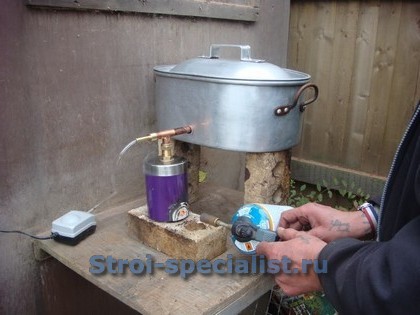
After loading the fuel and lightly compacting it, it is enough to bring the lighter to the hole in the body for a few seconds and start the smoke generation process.
Often, to improve the removal of the main product of the device from the combustion zone - smoke, a perforated steel tube or a tightly wound spring is installed inside the housing. It can be additionally fixed or made in a removable version.
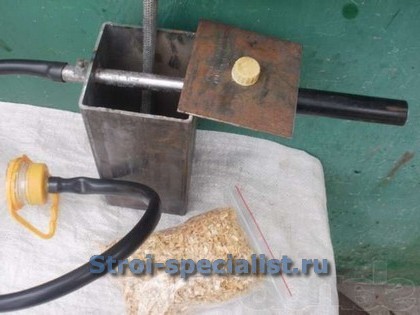
The removal of the gaseous mixture is carried out through the outlet tube, which can be attached directly to the body of the fixture using a welded seam or to its cover.
Providing better draft, mixing clean air and thick smoke, resulting in increased smoke flow, is achieved by using a simple system consisting of a small diameter metal tube and a flexible tubular actuator connected to a small compressor, such as an aquarium.
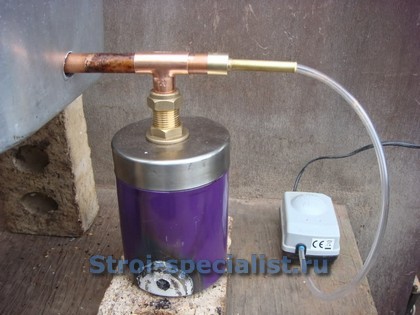
The air blower (thinner tube) must be fixed in such a position that its inner end enters the gas outlet tube by no more than 1 cm relative to the vertical axis of the entire device.
Careful attention must be paid to this fact when designing and manufacturing fixtures.
Do-it-yourself smoke generator assembly
In the case of organizing a small-sized home smokehouse, a simple smoke generator can be made from two cans of different sizes. One of them will serve as the body of the device, the second - as a fuel bunker.
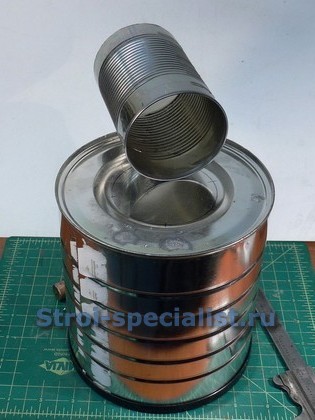
At the bottom of the larger container, mark a circle whose diameter is equal to the diameter of the bottom of the smaller jar. Use a ruler to divide the circle into eight segments.
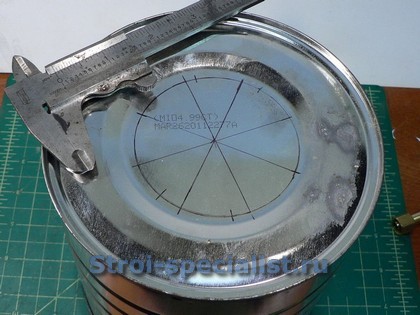

It is convenient to drill thin sheet metal with a centered twist drill (such drills are used for woodworking) at low feed and at medium speeds.
The hole is necessary for cutting the remaining parts of the circle segments to the circle line using an electric jigsaw with a metal file installed, which has a smaller tooth and a shorter length.

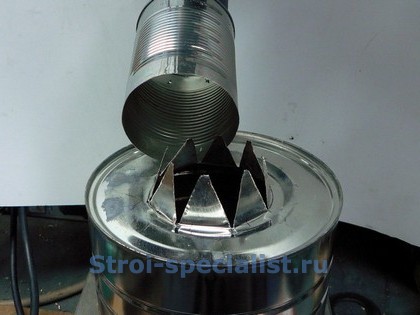
Next, in a smaller jar, stepping back from the bottom of 1 cm, we drill three holes with a diameter of 1/2 inch so that two of them are located strictly opposite each other, and the third is perpendicular to their axis. The holes located opposite each other will serve to fix the air supply tube, and the third hole is necessary to start the generator (ignition).
Now the jars can be put aside for a while and prepare the following details:
- A piece of half-inch galvanized pipe about 12 cm long with threaded threads on both ends;
- Half inch run;
- 1/2" male threaded brass fitting;
- Brass, copper or steel tube, the diameter of which allows it to enter the through hole in the fitting.
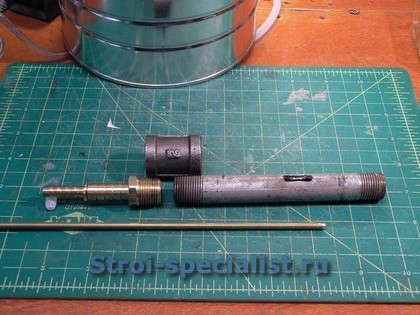
Approximately in the middle of the steel tube, using a drill, it is necessary to make one oblong (on a vertical milling machine) or several adjacent (on a drilling machine) holes with a diameter of 10 mm.
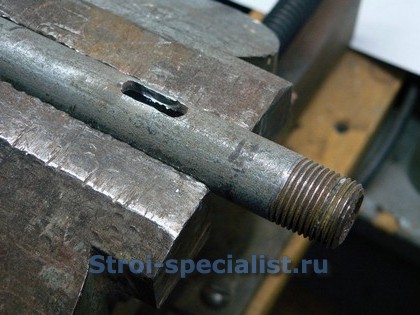
The next step is to connect the fitting to the steel tube using a squeegee and install a small diameter tube into it, on which you need to install a flexible compressor hose.
![]()
Next, we proceed to the assembly of the device. To do this, we mount small legs bent from a steel strip with a section of 1x15 mm at the bottom of a larger container. We fix a smaller capacity to the previously bent segments with metal screws.
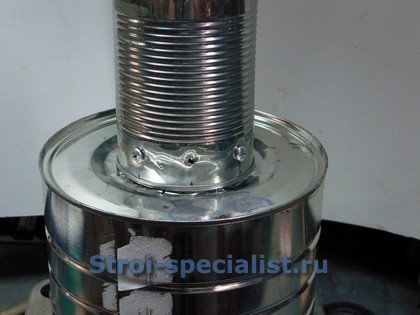
We install the previously assembled chimney into the corresponding hole. In this case, an oblong hole drilled in a half-inch steel tube should be located in the center of a smaller can.

Now let's move on to testing the resulting device. To do this, we install it in a convenient place and attach a compressor of sufficient power to the flexible hose.
We put fuel inside the bunker and the smoke generator itself, for example, hardwood pellets. Softwood contains a large amount of resin, which, when burned, gives a strong soot and an unpleasant odor. It is not recommended to use it to generate smoke in smokehouses.
When starting for the first time, it is necessary to experimentally find the best position for the thinnest tube of the smoke generator. As mentioned above, in this position, the end of this tube will be no further than 1 cm from the oblong hole. The air pumped by the compressor creates a rarefaction of air near the end of a thin tube - that is, in the area of \u200b\u200ban elongated hole through which smoke is removed from the sawdust smoldering zone. At the same time, by adjusting the position of the thin tube, you adjust the smoke characteristics that are required for your particular smoking process.
After making sure of the quality of our smoke generator, we install it near the inlet of the smoking chamber and start the production of delicacies for family and friends.
Examples of our readers
Petr Viktorovich Demin sent photos of his homemade smoke generator for discussion with a few comments on them:
For convenience, pictures can be enlarged.
“As an air blower, you can use a cooler from a laptop. It is like a mini-turbine, it can easily create the desired air flow in the D10 mm tube, 5 V power supply. allows you to twist it even from a cell phone battery. I'm happy with it. there was a hitch with the compressor and I had to urgently extricate myself. The photo with a bottle is a trial version with a small cooler, it worked disgustingly, it almost did not give traction.
There are marks on the air tube, this is for the convenience of adjusting the depth of its immersion. In the photo with the refrigerator - plastic water pipes, I made a transparent window to control smoke.
The body of the smoke generator is made of OP-5-1, it has a wide removable cover - it is convenient to fill up sawdust. The turbine used was too powerful for this unit, so I had to add a damper, although it was possible to put a power supply with voltage regulation. The air tube is made of a telescopic antenna."
Dear readers, if you still have questions, ask them using the form below. We will be glad to communicate with you;)